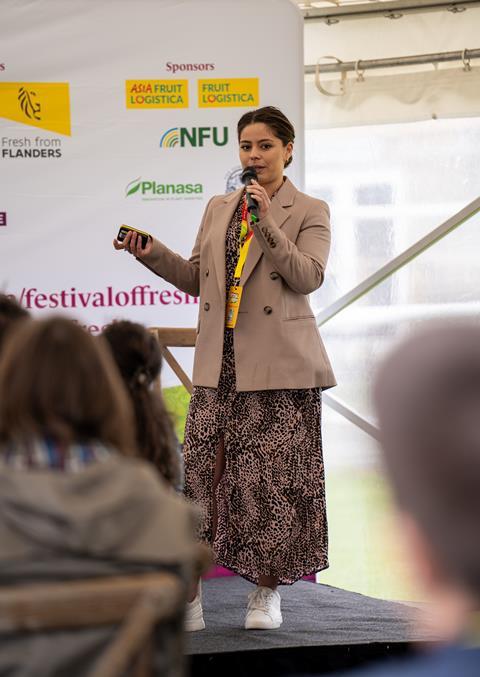Laura Fry, consumer insight director for produce, gave Festival of Fresh delegates an overview of the key trends driving retail sales

The fresh produce category is riding high at retail level this year, according to latest Kantar data.
Fresh fruit and veg sales are experiencing a five-year high in value terms at over £14bn, with volume sales now in growth for the first time since 2020 at 1 per cent, revealed Kantar’s Laura Fry.
Fruity favourites
Speaking at Festival of Fresh in Evesham last week, Fry, who is Kantar’s consumer insights director – produce, said price has been the driving factor for both fruit and veg sales over the last 12 months to May 2024. But she added more shoppers are buying fruit more frequently than veg.
Cucumber, onions and courgettes were the top three fastest growing produce within the vegetable sales category over the 12-month period, while peaches, blueberries and bananas saw the fastest percentage growth in sales within the fruit department, Fry said.
Retail winners
From a retailer perspective, Sainsbury’s, Aldi, Lidl and M&S have this year experienced the biggest share increase in total produce sales in value terms when compared to 2020.
The discounters and M&S are seeing more produce shopper frequency, Fry said. While M&S is attracting the most new shoppers within the fresh produce universe.
Meanwhile, Sainsbury’s is the only retailer in the market to see substantial growth in fruit and veg basket size, which is helping their overall performance.
Consumption trends
In terms of consumption, Kantar data shows an uplift of 70m fruit and veg occasions this year compared to pre-Covid. And that 46 per cent of all meals will this year feature either fruit or veg.
Fruit is has gained prominence at breakfast since 2019, but is losing share as a snack, Fry said.
Meanwhile, vegetables have lost share at main meal occasions, particularly in the evening since 2019.
Children have contributed most to the growth of fruit at breakfast. Whereas the loss in share of produce across snacking and main meals stems from young adults, she said.
Fry attributed the decline in veg consumption during main meals to the fall in scratch-cooking, which is at a five-year low since 2019.
Online opportunity
As for how people buy their produce, Kantar predicts online grocery shopping to gain share in 2024, driven by affluent shoppers returning to the platform.
Omni-channel shoppers (those who shop in-store and online) spend 291 per cent more than exclusively in-store shoppers, Fry explained. And Sainsbury’s holds the largest opportunity to grow its sales if more of its shoppers also shopped online. Morrisons and Waitrose are yet to reach their full sales potential online, Fry said.
Shopper spectrum
Kantar data showed a reduction in the proportion of UK shoppers who are struggling and just managing to afford food since November 2021. Meanwhile the percentage of shoppers falling within the ‘comfortable’ bracket has risen to 36 per cent.
Falling inflation won’t instantly relieve pressure on consumers, Fry warned. Grocery sales growth will come with caution.
Of the struggling shoppers, 78 per cent are looking for cheaper products to manage their spend. And 58 per cent of all shoppers are motivated to use loyalty cards as a money saving measure.
Brand-tastic
The gap between sales of fresh produce brands and own label produce has diminished in the 12 months to May 2024, Fry said.
Branded produce is “storming ahead” with the help of promotions, she said.
Shoppers are moving up and down between the price tiers (value, standard and branded/premium), though ‘standard’ still holds the biggest share.
Branded veg are driving the most growth for Ocado and Lidl in produce, she said, citing Keeling’s, Albert Bartlett, Driscoll’s, Fyffes and BerryWorld as growing produce brands within the grocery retail sector.